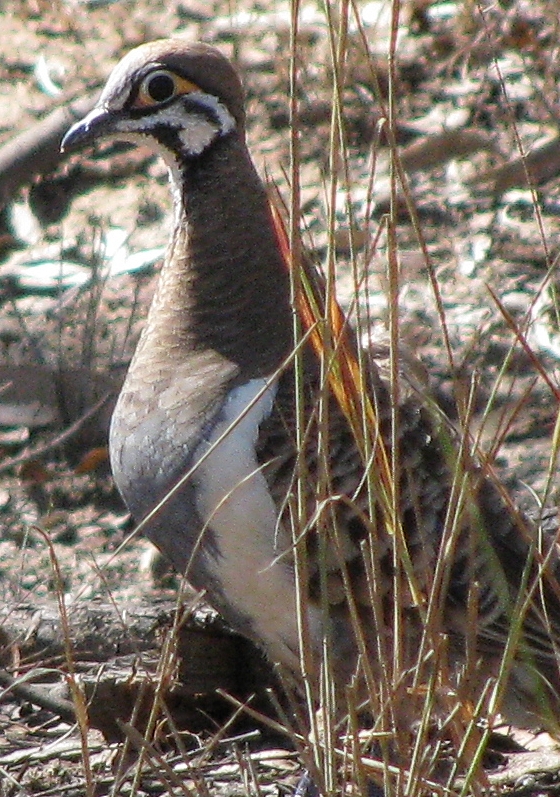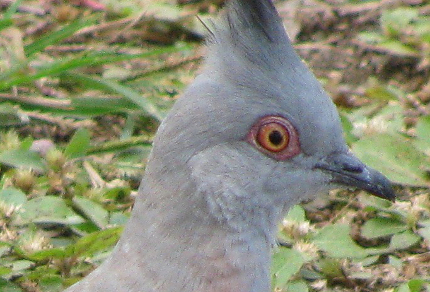
Crested Pigeon (© Magi Nams)
This morning while striding briskly alongside the golf course, I noted peaceful doves foraging on the ground and crested pigeons perched on overhead wires, the former species one of the most common birds in Townsville, and the latter one of the most handsome. I began to recall other pigeons and doves I’d seen during our time in Australia. The first were wee, red-eyed diamond doves I spotted in drenching rain during my first birding excursion on December 31, when the Wet slammed Townsville with 200 millimetres of precipitation in 24 hours. Peaceful doves, with their aqua eye rings and soothing, omnipresent cooings were next. Visits to Paluma yielded sightings of long-tailed, cinnamon-coloured brown cuckoo-doves, green-winged emerald doves, and a topknot pigeon with head feathers sculpted into a peculiar, wavy ‘do.’ I first spotted bar-shouldered doves, with their scarves of glistening copper and black, at the Townsville Town Common Conservation Park, and elegant white-and black pied imperial-pigeons in the lofty street trees bordering the Townsville Golf Course.

Squatter Pigeon (© Vilis Nams)
Excursions farther from Townsville offered opportunities to observe the deliciously-coloured and amusingly-voiced wompoo fruit-dove in rainforest surrounding Lake Eacham in the Atherton Tablelands, the striking squatter pigeon of the dry inland country surrounding Burdekin Dam Falls and Undara Volcanic National Park, and a flock of white-headed pigeons with slate-coloured wings and red beaks and eye rings winging over Zoe Bay on Hinchinbrook Island.
Rock doves, which abound in Townsville and other Australian urban centres, were introduced by early European colonizers, as were spotted turtle-doves, which are native to southern China and the Malaysian region, and were brought into the country starting in the 1860’s.1 Spotted turtle-doves are far less common in Townsville than rock doves, but I have observed them along the Ross River Parkway near James Cook University. Another introduced species, the laughing turtle-dove, occurs only in southwestern Western Australia.
All doves and pigeons belong to the avian family Columbidae, of which there are 297 species worldwide and 25 species in Australia, a trio of which were introduced,2 as I’ve already mentioned. Members of this family tend to have plump bodies and small, rounded heads, with the larger species generally classed as pigeons and the smaller species as doves.2 However, this name/size distinction becomes blurred in Australia, with some of the fruit-doves and the brown cuckoo-dove as large or larger than many pigeon species.3

Peaceful Dove (© Magi Nams)
Pigeons and doves occupy many and varied habitats. Rainforest species, such as the superb, rose-crowned, and wompoo fruit-doves, white-headed, wonga, and topknot pigeons, pied imperial-pigeon, and brown cuckoo-dove feed on fruits and berries4 and are important dispersers of rainforest seeds. Spinifex pigeons and chestnut-quilled and white-quilled rock-pigeons inhabit rocky hill country or escarpments and gorges, feeding primarily on seeds and seeking shelter in the rugged terrain.5 Aside from urban centres, crested pigeons can be found in farmlands, pastures, and croplands, while emerald doves, which I’ve observed along a roadside in Paluma and beside the Ross River in Townsville, hang out in rainforest clearings and edges.6 Bronzewings, which are medium-sized pigeons, inhabit dense scrubby forests (brush bronzewing), forests and shrub thickets (common bronzewing), or treeless plains (flock bronzewing).7 Squatter and partridge pigeons typically inhabit grassy woodlands,8 which is the type of vegetation in which Vilis and I observed squatter pigeons at Undara, while diamond, peaceful, and bar-shouldered doves may be found in woodlands and scrubs, often near water.9
Species of doves and pigeons inhabiting open landscapes are, needless to say, much more easily observed and photographed than those occurring in dense cover. I’ve heard the distinctive, rolling “wwrrrom-poo!” of the wompoo fruit-dove on numerous occasions in the rainforests Vilis and I have visited, but have only once actually seen this gorgeous, green-gold-burgundy-grey bird, and even then it was screened by dense branches that rendered a photograph impossible. I’m hoping the desert country around Alice Springs will provide clear, photographable sightings of spinifex pigeons and common bronzewings. We leave on Friday.
Reference:
1. Graham Pizzey and Frank Knight. The Field Guide to the Birds of Australia. 1997. Angus & Robertson, Sydney, p. 242; 2. Ibid, p. 532; 3. Ibid, pp. 244-257; 4. Ibid, p. 246, 248, 254, 256; 5. Ibid, p. 250; 6. Ibid, p. 246, 250 ; 7. Ibid, p. 248, 252; 8. Ibid, p. 252; 9. Ibid, p. 244.


